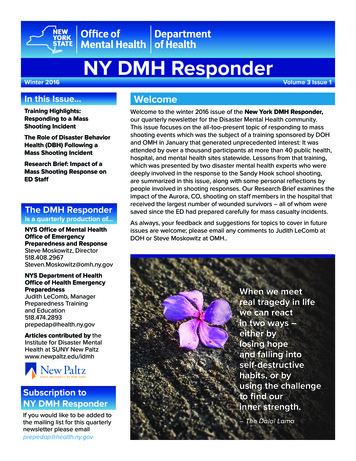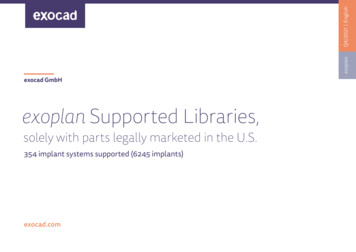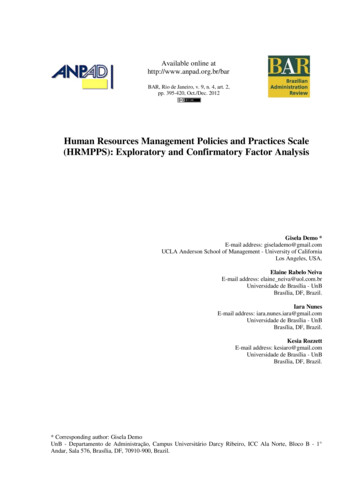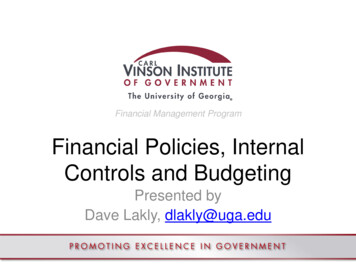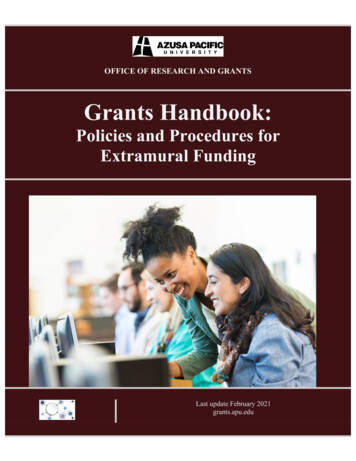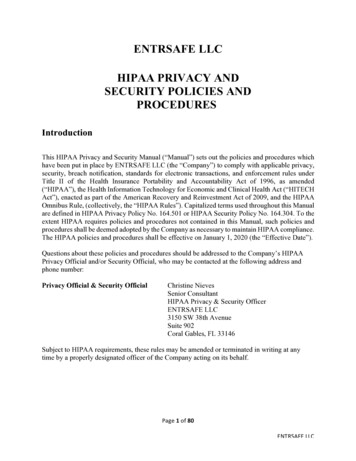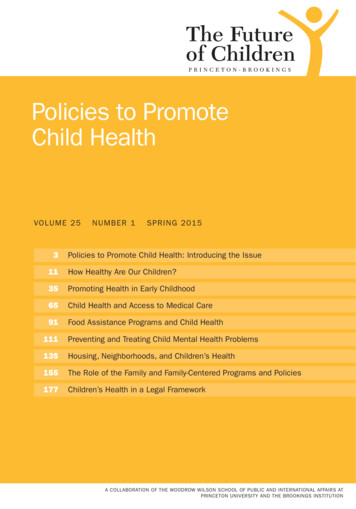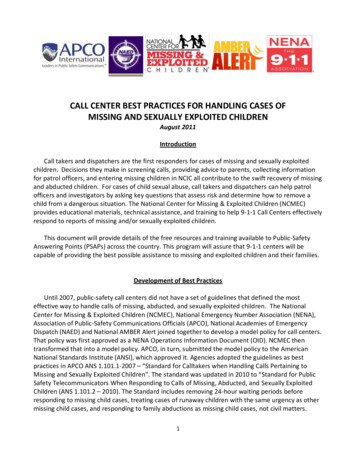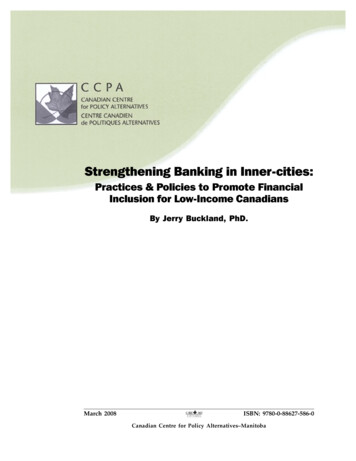
Transcription
Strengthening Banking in Inner-cities:Practices & Policies to Promote FinancialInclusion for Low-Income CanadiansBy Jerry Buckland, PhD.March 2008ISBN: 9780-0-88627-586-0Canadian Centre for Policy Alternatives–Manitoba
About the AuthorJerry Buckland, PhD., is the Coordinator and Professor, International Development Studies, Menno Simons College—part of Canadian Mennonite University, affiliated with the University ofWinnipeg. He was the research lead ofa 2003 study of bank branch closuresand the rise of fringe banking servicesin Winnipeg’s North End, which waspublished by the Winnipeg Inner-cityResearch Alliance (WIRA). He co-wrotethe 2005 Canadian Centre for Policy Alternatives–Manitoba paper, Fringe Banking in Winnipeg’s North End.AcknowledgementsI would like to thank Jennifer Robson,Rick Eagan, Harold Jantz and AndrewDouglas, and two anonymous reviewers for their thoughtful comments on earlier drafts of this paper. Thanks also toShauna MacKinnon, Director of Canadian Centre for Policy Alternatives–Manitoba for her support for this projectand special thanks to Doug Smith for hiscareful editing of the manuscript.Part of the research drawn on for thisstudy was supported by a research grantfrom Social Sciences and Humanities Research Council (SSHRC) and the Winnipeg Inner-city Research Alliance (WIRA).This report is available free of charge from the CCPA website at http://www.policyalternatives.ca.Printed copies may be ordered through the Manitoba Office for a 10 fee.iStrengthening Banking in Inner-cities
Table of Contents1I)8II) Tailoring financial services for low-income peoplea) Information about financial services & feesb) Building respectful & trustworthy relationshipsc) Accessibility to financial servicesd) Appropriate financial servicesi) Savings schemesii) Credit schemesiii) Tailor financial service technologies for low-income people14III) General types of government action to promote financial inclusiona) Government policyi) Regulating & supporting basic banking services1) Requiring banks to provide a minimum set of bankingservices at all branches2) Requiring banks to demonstrate universal provision ofbanking services in entire working area3) Supporting local solutionsii) Consumer protectioniii) Ensuring competition in financial marketsiv) Ensuring foreign investment benefits the economyv) Facilitating savings & financial inclusion in welfare programsb) Government service provisioni) Provision of financial servicesii) Provision of education on financial managementiii) Universal personal identification27IV) Summary & Discussion28Introductiona) What is financial exclusion?b) The Poverty-Financial Exclusion Relationshipi) Non-rational/a-institutional theoryii) Rational/a-institutional theoryiii) Rational/institutional theoryiv) Institutional Theories & Financial ExclusionBibliographyCanadian Centre for Policy Alternatives–Manitobaii
iiiStrengthening Banking in Inner-cities
Strengthening Banking in Inner-cities:Practices & Policies to Promote FinancialInclusion for Low-Income CanadiansI) IntroductionAt least 3% of Canadian adults and 8%of low-income Canadian adults have nobank account. Typically they conducttheir financial transactions at what havecome to be known as fringe banks, suchas a cheque-casher. There, they payhigher fees for a more limited set of services than people who use banks or creditunions. Cashing a cheque may cost 510 while borrowing 100 for 12 daysthrough a payday lender may cost 20.Since the financial services available fromfringe banks are limited to ‘transactional’services such as cheque cashing andmoney wiring, the financially excludedcannot open savings accounts or buildor repair their credit rating. In this wayfinancial exclusion is self-reinforcing:without savings or a positive credit rating it is difficult to obtain credit cards,lines of credit, or bank loans. Since fringebanks are usually weakly regulated, theirbusiness practices vary significantly.The number and variety of fringe banks,which operate on the margins of the financial services market primarily providing services to low and modest-middleincome people, are growing. The fringebank category generally includes paydaylenders, cheque-cashers, rent-to-ownshops, pawnshops, income-tax refundadvancers and sub-prime lenders (e.g.,Wells Fargo). Other non-financial institution providers (e.g., President’s ChoiceFinancial) may be yet another tier ofbanking institution. The numbers ofoutlets of some fringe banks, such aspayday lenders,1 have grown rapidly inthe last ten years bringing fringe banksincreasingly into mainstream awareness. The Canadian Payday Lenders Association represents 500 of the 1350 outlets operating in Canada and it estimatesthat between 1.5 and 2 million Canadians use a payday loan every year. 2Along with other fringe banks, such aspawnshops, they are often concentratedin inner cities.The expansion of the fringe-banking sector comes at a time when Canadian banksare experiencing record-breaking profitsand high levels of concentration, with thetop five banks controlling 90% of all bankassets. Even as the banks prosper, thereis evidence in some locales that branchclosures are disproportionately hittinglow-income inner cities.3Some would argue that these changes aresimply the outcomes of an efficient competitive market and do not present society with a major challenge. Alternatively,1 Many payday lending firms provide a number of services including cheque-cashing, moneywiring, money orders, bill payments, debit cards, secured credit cards, etc. They are sometimes referred to multi-service fringe banks.2 See, Canadian Payday Lenders’ Association, available: http://www.cpla-acps.ca/english/home.php, accessed May 2007.3 For instance, inner-cities in Toronto, Vancouver and Winnipeg.Canadian Centre for Policy Alternatives–Manitoba1
one might argue that these trends, whenconsidered in conjunction with the growing evidence of stagnating incomes andassets at the bottom of the income rangeand a growing disparity between rich andpoor, may in fact be problematic. Is itpossible that the emergence of a fringebank sector, with higher fees and limitedservices associated with it, will reinforcethe poverty that created it?While it is not possible here to completelyrule out either of these arguments, itwould seem wise for government, banks(mainstream and fringe), and communityorganizations to consider the possibleconsequences of the latter explanation.If poverty has been a primary driver offinancial exclusion, then more povertywill likely result from further exclusion.Policy reform is needed to promote financial inclusion that is consistent with anational anti-poverty strategy.4 This paper describes the key government policies that could increase financial inclusion, including the regulation of financial institutions, consumer protection,regulation of competition and foreigninvestment, welfare programs, and government provision of financial services.This paper does not provide an exhaustive list of policies related to financialinclusion nor does it generate a thorough analysis on issues it covers. Thegoal of this paper is to introduce theprincipal policies related to increasingfinancial inclusion.The report begins by defining and quantifying Canadian financial exclusion andthen presents various theories offered toexplain it. It then proceeds to provide aset of suggestions as to how bankingservices can become more relevant forlow-income households. Finally, it runsthrough a set of policy options that couldpromote financial inclusion. To provideevidence or examples, this paper drawson research on financial exclusion conducted in Winnipeg in the last five years.5a) What is financial exclusion?People are said to be financially excludedwhen they have no functioning depositaccount at a ‘mainstream’ bank. ‘Mainstream’ banks are financial institutionsregulated by federal or provincial legislation. They include domestic banks, foreign bank subsidiaries, foreign bankbranches, trust companies, mortgagecompanies, credit unions 6 and caissespopulaire. The term ‘no functioning deposit account’ describes the condition ofboth people have no bank account andthose may have an account but has notused it for several months. The financially excluded (the unbanked, or possibly underbanked) obtain financial serv-4 For instance see, National Council on Welfare. 2007. ‘Solving Poverty: Four cornerstonesof a workable national strategy for Canada,’ available: http://www.ncwcnbes.net/en/contactcontactez.html, accessed May 2007, National Council on Welfare, Ottawa.5 For more information on this research see Buckland & Martin, 2005; Buckland, Hamilton& Reimer, 2006; Buckland et al., 2003.6 For the purposes of this report credit unions and caisse populaires are grouped as amainstream bank. This is not to suggest that credit unions and caisse populaires operateidentically to federally regulated banks. One key difference is their governance modelwhich is based on membership not, as with banks, shareholders. Of the four communitybased financial service models described in section IV, three of them are related in somefashion to credit unions and caisse populaires. Credit unions and caisse populaires mayplay an important role in addressing financial inclusion but their resources are limitedrelative to banks.2Strengthening Banking in Inner-cities
ices from informal and fringe financialservice providers. Examples of informalfinancial services are small loans fromfriends or family and cheque-cashingfrom a corner store owner. The fringebanking sector is growing category offirms (pawnshops, cheque-cashers, rentto-owners and payday lenders) that areweakly regulated and offer loans andbasic transactions services (cheque-cashing, money wiring, bill payments).At least 3% of Canadian adults and 8%of low-income adults are without a bankaccount. While there is insufficient datato say whether the problem is worsening, there is evidence that, in terms ofthe proportion of the population affected, it is not improving. Surveys in1996, 2001 and 2005, all with biases thatunder-report low-income people, foundthe unbanked proportion of the adultpopulation has stagnated at 3%.7 If the3% figure is accepted as a minimum proportion of unbanked Canadians, thismeans that the number of unbanked hasrisen from 753 thousand in 1996 to over842 thousand in 2005. If the proportionis 5%, then 1.4 million people wereunbanked in 2005 (Table 1).While these rates are lower than those inthe United States (where 12-13.5% alladults and 41% low-income adults arefinancially excluded), they hover near therates of financial exclusion in the UnitedKingdom. Since financial exclusion isconcentrated among low-income people,it is more likely to reinforce poverty andother types of exclusion. Financial exclusion is often associated with reliance onfringe banks for one’s financial services.Studies have found that low-income people rely on fringe bank services to agreater extent than middle and high-income people.At fringe banks service fees are typicallyhigher than those charged by mainstream bank services, services are focusedon immediate transactions, and sincethere is limited government regulation,business practices can be more risky forconsumers. Since fringe banks generallyprovide only limited transaction servicesand no saving services, they do not giveconsideration to or advice about the customer’s overall financial situation. Thusfinancial services decisions are made without an understanding of the client’s financial context.Table 1. Minimum Number of Unbanked in Canada, 1996-2005YearPopulationAdult Populationa3% Unbanked5% 656842,2601,349,4271,403,767a. Assuming a constant adult share of the population, at 87%.7 The MacKay Report states that 3% of Canadian adults and 8% of Canadian adults withhousehold incomes less than 25,000 are unbanked. Due to the telephone method bias—more low-income households are without a telephone and therefore would not be interviewed—low-income households are likely underrepresented in the study. Since low-incomeCanadians are disproportionately financially excluded this will understate both rates. If thetrue figure for financial exclusion among low-income households is double the MacKayestimate, that is, 16%, then the overall unbanked rate would be higher. Adults representapproximately 87% of Canada’s 32 million people, i.e., 28 million people. If 15% of theseadults are low-income, then the national financial exclusion rate is ((16% x 15% x 28million) (3% x 85% x 28 million))/28 million (672,000 714,000)/28 million 1.39million/28 million 5.0%.Canadian Centre for Policy Alternatives–Manitoba3
Fees for cashing one cheque at a chequecasher can rival the monthly fee for a lowfee account at a mainstream bank. Theannual percentage rate of interest (APR)for a pawnshop loan can hover around250%, while APRs for payday loans rangefrom 250% to 1000%. Higher fees reflect,in part, the costs of providing a largevolume of small transactions. In somerespects, fringe bank costs are higherthan those experienced by traditionalbanks since it is less profitable for fringebanks to cash a large number of smallcheques than for banks to cash a largenumber of cheques, many of which arefor large values. Similarly banks havelower costs on their comparatively largerloans.8 Since cheque-cashers provide immediate cash (while banks place a holdon cheques until they clear) chequecashers must run the additional risk ofthe cheque not clearing.Fringe banks encourage loan repaymentextensions that can lead to large increasesin interest rates. Their complex and undisclosed fees also represent another challenge to consumers. For example, fees forpayday loans may involve three to fourcomponents, some of which are valuedin dollars, while others are valued in percentages, making it very difficult to comparison shop. Finally, fringe banks gen-erally do not offer savings or credit-building services that allow clients to buildtheir financial position. As result, a reliance on fringe banks can, on its own,act as a barrier to becoming banked. Thesedisadvantages can reinforce the low income and low assets that generated theconnection between the client and thefringe bank to begin with, reinforcing asecond tier of banking, and possibly aggravating income inequality.b) The Poverty–FinancialExclusion RelationshipThis section sketches a few of the theories that have been developed to explainthe relationship between low-income people and the financial system. Two criteria that can be used to categorize thesetheories are their assumptions about consumer rationality and the considerationthey give to the role of institutions and/or political economy. If one considersthese as two continuums then it is possible to find theories that fit into fourtypes of theories, although only three areconsidered here:9 non-rational/a-institutional10, rational/a-institutional and rational/institutional. Readers less interested in theory might skip parts (i)through (iii) and go directly to part (iv).8 Excepting the cost to the firm of a bad cheque or defaulted loan. If one small cheque orloan goes bad, the loss to the fringe bank is small. If one large cheque or loan goes bad, thecost to the bank could be large.9 We do not consider the non-rational-institutional theory as it has not been applied tounderstanding financial service choice. Early development economic theories assumed thatconsumers behave in non-rational ways. In the 1950s modernization theory postulated thatsome people, usually referring to peasants, were non-rational since they did not, for instance, respond to higher wages. These theories have been rejected for their bias towardsWestern notions of rationality and excessive emphasis on economic factors. Modernizationtheories were usually institutional in that they found that irrationality could be overcome, anddevelopment achieved with the introduction of modern education and state institutions.Modernization theories have been largely rejected in the development literature.10 By a-institutional it is meant that the theory does not explicitly analyze the role ofinstitutions broadly defined (referring to social and economic institutions) or narrowly defined(referring to norms and rules).4Strengthening Banking in Inner-cities
i) Non-rational/a-institutionaltheoryA recent theoretical approach that acceptsnon-rationality or ‘bounded’ rationality,this time largely referring to consumerbehaviour has been tested by experimental or behavioural economics. This approach has sought to understand seemingly non-rational consumer behaviour,for instance when a person pays a veryhigh fee for a loan when a lower fee alternative exists. What they demonstrateis that people behave in complex waysthat do not always conform to the assumptions of consumer rationality inneoclassical economics. Paying thehigher fee for a loan may reflect othereconomic costs (the cost of gathering information, the cost of obtaining theloan), social costs (the costs of experiencing stigma and disrespect in engaging certain services) and the impact onthe consumer of advertising.These methods and theories are very useful in unpacking the concept of rationality imbedded in neoclassical economicmodels.11 They point to the complexityof consumer behaviour and claim thatrationality is not as simple as the neoclassical model would suggest. For instance, a large experimental study of con-sumer behaviour regarding loan choicein South Africa found that consumersbehave in ‘bounded’ rational ways. Bybounded rationality it is meant that aperson cannot or does not take into account all relevant information to makeher decision.12One limitation of these theories is thatthey tend to be a-institutional: they focus on consumers’ behaviour as if theyoperated within a perfectly competitivemarketplace without institutional influence. Yet consumers do not operate in aninstitutional vacuum: firms’ advertisingand government spending on programssuch as health-care, education and welfare are examples of institutional factorsthat affect consumer behaviour.ii) Rational/a-institutional theoryMany theories, including neoclassical,assume that consumer behaviour is rational. According to neoclassical economictheory, if provided with reasonably pricedcredit, poor people can act as a cornerstone of a growing economy. This theoretical perspective has been borne out inpractice. In the early 1970s, the GrameenBank in Bangladesh under the headshipof Bangladeshi Mohamed Yunus, blendedmodern institutional elements (staff moni-11 Neoclassical economics is the dominant economic theory today. The roots of thisapproach are in the classical political economy school associated with Adam Smith,David Ricardo and Robert Thomas Malthus. But the contemporary impetus came in thelate 19th century by William Jevons, Leon Walrus and Carl Menger with the applicationof marginal analysis to economic decision-making. It posits that consumers are rationaleconomic agents, and that the market—free of government intervention (taxes andregulations) and other “imperfections” such as unions—is the most efficient way ofdistributing resources and wealth. By decentralizing economic decision-making to countless consumers and firms in many markets, neoclassical economics finds that socialwelfare is optimized. The theory assumes that markets are perfectly competitive (meaning that no one actor can influence market outcome) and that consumers have access toperfect information about the goods they purchase.12 In Canada, the Center for Interuniversity Research and Analysis on Organizations,CIRANO, has an experimental economics group that has used experimental economics tolook at a variety of issues including labour and financial markets.Canadian Centre for Policy Alternatives–Manitoba5
toring and support) with those of traditional credit systems (peer monitoring andsupport). Yunus’s pilot project has growninto a bank with almost seven-millionborrowers and, perhaps more profoundly,has inspired hundreds of micro-creditprojects around the world. The GrameenBank’s success, according to Yunus (whoreceived the Nobel Peace Prize for hiswork), arises from the fact that poor people are rational, hard working and in factentrepreneurial.iii) Rational/institutional theoryAn institutional theory is one that explicitly theorizes the role of institutions—broadly defined as social and politicalactors and processes or narrowly definedas legal rules and social norms—in theeconomy. Most institutional theories related to financial exclusion fit within therational consumer category with somefocussing on the micro level (the level ofconsumers and firms) while others focuson the macro level (the level of the nation or international economy).Sherraden and Barr (2004, 2005) use amodel that is rooted in institutional economics that sees individuals operatingwithin a social and institutional setting.It rejects the neoclassical assumption thatall consumers, poor and rich operatewithin frictionless and competitive markets. Institutional theory sees institutions, including markets, the state andsociety as important intermediaries ofhuman behaviour. This theory also rejects the idea associated with the cultureof poverty theories that the poor are inherently different than the non-poor. Theinstitutional theory of savings assumesthat poor people behave like non-poorpeople but that they face a different set ofinstitutions. The model assumes that individuals are “complex and their cognition and emotions can affect action,” con6sistent with a nuanced understanding ofhuman behaviour (Sherraden and Barr2004, 8). Institutional theories find thegreatest social and economic problems arelocated where both institutions and behaviour break down.Concentrating on the macro level, Caskey(1994) argues that macro-economic trendsin the U.S. explain the growth of fringebanking in the U.S. in the 1980s andearly 1990s. He argues that declining incomes among working-class Americansand a growing income divide betweenrich and poor are demand-side (that isaffecting consumers) factors that increasefinancial exclusion. With lower or stagnant incomes, people have fewer incentives to save and less likelihood of building a credit rating to access credit. Supply-side (affecting firms) factors that workto increase financial exclusion include theincreases in fees on deposit accounts, decline in branches especially in inner-cities, reduction in non-revolving, unsecured consumer lending and small loancompanies, increases in gold prices andrising awareness of the business opportunities of fringe banking. These factorsmake bank accounts more expensive,small loans less available and access tolocal banks more difficult.iv) Institutional Theories &Financial ExclusionThis report builds on a rational-institutional theory of financial exclusion. Itbelieves that consumers—whether lowincome or not—generally behave in understandable ways that enhance theirself-perceived well-being. This is not toreject insights gained from experimentaleconomics that aid our understanding ofconsumer behaviour. This report embraces theories that integrate the institutional context at both the micro andStrengthening Banking in Inner-cities
macro levels. At the macro level13, manyof the factors that Caskey (1994) identifies as explaining financial exclusion inthe U.S. may apply to Canada, e.g., declining or stagnating incomes of thepoor, mainstream bank branch closures.At the micro-economic level, drawing onSherraden and Barr (2004, 2005), it canbe argued that low-income households,like all other households, pursue financial strategies that are consistent withtheir life goals. These financial strategiesaffect decisions about financial services.Households consider direct and indirecteconomic and social costs of mainstream,fringe and informal banking services. Ingeneral, these households choose thoseservices that best facilitate their financialand life goals. There are, of course, limitations to information processing.Robson (2007) points out that evidencefrom the U.K.14 finds that many people—from various income groups—when confronted with too much information andtoo many options, don’t shop around for,and don’t fully understand their financial services.Arguably, neoclassical economic theoryis very influential on economic policy inCanada today. The theoretical frameworkguiding this report (rational-institutional) is consistent with the neoclassical economic framework about humanrationality but deviates from it in regardsto the role of institutions. Thus, this report advocates policies that may be in-consistent with neoclassical economictheory. For instance, consumer protection flowing from neoclassical economictheory would only consider the importance of the individual and would notunderscore how class, ethnicity or gender affects the consumer. An institutionaltheory would be concerned with howdifferent groups, and in particular, lowincome groups, are affected as consumers of financial services.Nevertheless, to the extent that low-income people, like all other people, informthemselves about their financial services,they consider three main types of costs:direct economic costs, indirect economiccosts, and social costs. Direct economiccosts include all the fees applied to theservice, indirect economic costs includethe costs of travel and time to travel toobtain the service. Direct social costs relate to the social experience of the clientwith the bank staff and in particular theirsense of respect and trust towards the staffand institution. The calculation of thevarious benefits and costs of mainstream,fringe and informal financial services canlead to surprising results. For instance,some low-income people may choose tocash their cheque at a cheque-casher eventhough the direct economic costs arehigh. This is because the indirect economic and direct social costs of fringebank services may be low relative tomainstream bank services.13 An important macro-level analysis is Gary Dymski’s (2003) work, drawing on the StiglitzWeiss new-Keynesian macroeconomic model, which argues that market imperfections suchas asymmetric information and monopoly power led financial institutions to segment thefinancial service consumers into two groups—with low-income people being forced intodoing business with sub-prime lenders and fringe banks while middle and upper-incomepeople are streamed into mainstream bank financial services. He argues that these twomarket segments have become separated making it difficult for low-income people to moveinto a relationship with mainstream financial service providers.14 For instance see, Atkinson, McKary, Collard & Kempson, 2007.Canadian Centre for Policy Alternatives–Manitoba7
II) Tailoring financial services for low-income peopleThe delivery of financial services by banksin useful, convenient and respectful waysis a key to increasing financial inclusion.This can be done by ensuring that information about financial services and products is easily available, developing products that meet the unique financial needsof low-income people, and providingthese services in respectful ways that giveclients a sense of control over their lives.a) Information about financialservices & feesA consumer requires an understandingof a product, including its characteristics and fees, before she can determine ifit meets her needs. Low-income peopleface two related information problemswhen they seek out financial services.Mainstream banks do not widely publicize those services that they provide thatwould be of relevance to low-income people while information about fringe bankfees is often not presented or presentedin an overly complicated manner.Relevant information about a bank account includes: how to open an account(personal identification requirements),how to maintain it (minimum balances,how many free transactions), and themonthly fee. Banks are required to accept certain types of personal identification to cash cheques and open accounts,they have voluntarily agreed to providea basic ‘low-fee’ account (usually 4- 6 amonth for 10-15 transactions) and bankshave agreed to cash federal governmentcheques of up to 1,500 for no fee. Whilebanks provide these services, the servicesare not necessarily well publicized.Services offered by fringe bank are oftenbetter advertised than basic bank services at mainstream banks. However, feeinformation may not be presented in aneasy-to-understand manner. Administration fees, cheque-cashing fees, interestcharges can be applied in a lump sum orin variable, daily or monthly rates, making it very difficult to determine the totalfee for a fringe bank service. This rendersit all but impossible to shop around forthe best financial service. This is important since fringe bank fees can vary fromfirm to firm. In Winnipeg, while pawning fees are consistent across shops,cheque-cashing fees vary somewhat andrent-to-own and payday loan fees varyconsiderably (Buckland et al., 2003).A variety of policies could be introducedto make financial services more accessible to low-income people and to makeinformation about the cost of those services more understandable. While bankshave agreed to accept standardized personal identification requirements, openlow-fee accounts and not charge for cashing federal government cheques, theycould also be required to publicize theseservices and policies. Banks could provide information about these services onposters in the branches and broadly advertise these services in the same way thefringe banks advertise their services.The joint federal, provincial and territorial Consumer Measures Committee1515 The CMC “provides a federal-provincial-territorial forum for national cooperation toimprove the marketplace for Canadian consumers, through harmonization of law
payday lenders,1 have grown rapidly in the last ten years bringing fringe banks increasingly into mainstream aware-ness. The Canadian Payday Lenders As-sociation represents 500 of the 1350 out-lets operating in Canada and it estimates that between 1.5 and 2 million Canadi-ans use a payday loan every year.2 Along with other fringe banks, such as
